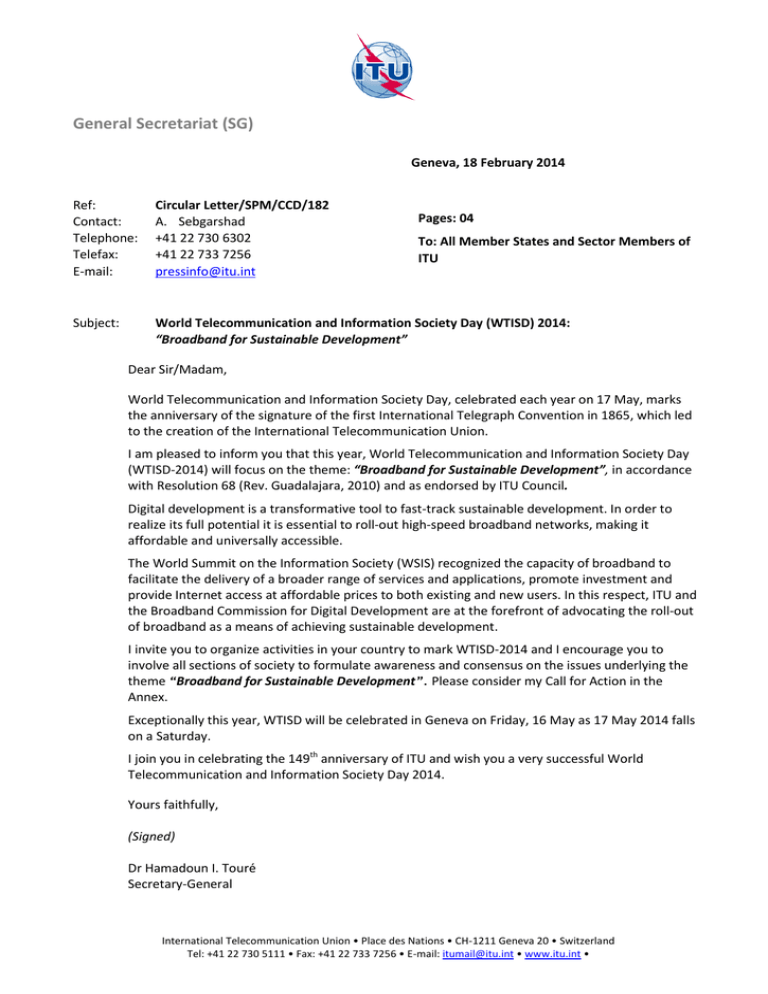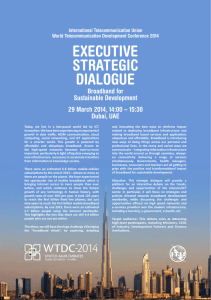General Secretariat (SG)
advertisement

General Secretariat (SG) Geneva, 18 February 2014 Ref: Contact: Telephone: Telefax: E-mail: Circular Letter/SPM/CCD/182 A. Sebgarshad +41 22 730 6302 +41 22 733 7256 pressinfo@itu.int Subject: World Telecommunication and Information Society Day (WTISD) 2014: “Broadband for Sustainable Development” Pages: 04 To: All Member States and Sector Members of ITU Dear Sir/Madam, World Telecommunication and Information Society Day, celebrated each year on 17 May, marks the anniversary of the signature of the first International Telegraph Convention in 1865, which led to the creation of the International Telecommunication Union. I am pleased to inform you that this year, World Telecommunication and Information Society Day (WTISD-2014) will focus on the theme: “Broadband for Sustainable Development”, in accordance with Resolution 68 (Rev. Guadalajara, 2010) and as endorsed by ITU Council. Digital development is a transformative tool to fast-track sustainable development. In order to realize its full potential it is essential to roll-out high-speed broadband networks, making it affordable and universally accessible. The World Summit on the Information Society (WSIS) recognized the capacity of broadband to facilitate the delivery of a broader range of services and applications, promote investment and provide Internet access at affordable prices to both existing and new users. In this respect, ITU and the Broadband Commission for Digital Development are at the forefront of advocating the roll-out of broadband as a means of achieving sustainable development. I invite you to organize activities in your country to mark WTISD-2014 and I encourage you to involve all sections of society to formulate awareness and consensus on the issues underlying the theme “Broadband for Sustainable Development”. Please consider my Call for Action in the Annex. Exceptionally this year, WTISD will be celebrated in Geneva on Friday, 16 May as 17 May 2014 falls on a Saturday. I join you in celebrating the 149th anniversary of ITU and wish you a very successful World Telecommunication and Information Society Day 2014. Yours faithfully, (Signed) Dr Hamadoun I. Touré Secretary-General International Telecommunication Union • Place des Nations • CH-1211 Geneva 20 • Switzerland Tel: +41 22 730 5111 • Fax: +41 22 733 7256 • E-mail: itumail@itu.int • www.itu.int • –2– ANNEX ITU Secretary-General’s Call for Action World Telecommunication and Information Society Day 2014 The theme for WTISD-14, “Broadband for Sustainable Development”, will focus attention on multistakeholder commitment to achieve universal access to broadband connectivity and content and foster political will on achieving this objective; identify key gaps in broadband research and development, infrastructure, and packaged development of applications and services; define policy priorities for action in the areas of allocating radio frequency spectrum for broadband, universal access obligations and innovative financing mechanisms; and lead to technological solutions, particularly in the extension of broadband access into rural areas, least developed countries and small island developing states. Given that estimates suggest that mobile broadband subscription may achieve 10 billion by the end of this decade and that over 90 per cent of international data traffic runs over fibre-optic cables ITU’s thrust to push the broadband agenda for sustainable development focuses on the dual goals of supporting the deployment of mobile broadband based on ITU’s International Mobile Telecommunications (IMT) and the continued rollout of fixed-line technologies. International consensus achieved on ITU standards and radio spectrum related activities for mobile telephony, fibre optics and access standards such as DSL, is the key to achieving the goals of universal access. The evolution of this work is complemented by key activities including earth monitoring through satellites and oceanographic radars, developing green standards and smart interventions to combat climate change, and m-Powering development. Broadband infrastructure development is a critical element in ensuring that ICTs are used innovatively as delivery vehicles for health, education, governance, trade and commerce in order to achieve sustainable socio-economic growth. Education is a keystone for educating people with regard to the impact and consequences of their activities for sustainable development, thereby ensuring a better future for all. As the leading specialized agency of the United Nations for information and communication technologies (ICT), ITU looks towards its Members to harness the catalytic role of ICTs in achieving sustainable development. I invite all Members of the Union to take practical steps to further national and domestic policies to accelerate the roll-out of broadband and to make it more affordable and accessible to all citizens, as a means of empowering them with information and knowledge to meet their aspirations and to achieve the overall goals of sustainable development. Call for Action: “Broadband for Sustainable Development” Develop and adopt national policies and plans promoting the roll-out of broadband networks, applications and services. The links between broadband deployment and economic growth are now relatively well-established. A 10 per cent increase in broadband penetration could increase growth in GDP by up to 1.38% (ICT 4 Development Report 2009, World Bank). For every job lost through the emergence of the Internet, between 2.4-2.6 jobs may emerge (Internet Matters Report, McKinsey Global Institute, 2011). ITU/Cisco research indicates that adoption of a broadband plan is associated with 2.5% higher fixed broadband penetration, and 7.4% higher mobile broadband penetration on average. Adoption of a National Broadband Plan may help focus efforts across the industry, in coordination with policymakers, emphasize the role of broadband as a national priority, and signal national commitment to the roll-out of broadband (Planning for Progress: Why National Broadband Plans Matter, ITU/Cisco, 2013). 3 The full benefits of broadband are most likely to be realized where there is strong partnership between Government, industry and other stakeholders, and where policy-makers engage in a consultative, participatory approach. Call for action: Relevant Government Ministries, regulators and agencies should prioritize the implementation of policies that promote the deployment of broadband, as part of a broader vibrant and diversified ICT sector. This could include the following: a. Conduct a national benchmarking exercise and/or public consultation on the state of national broadband infrastructure. b. Consider both demand and supply side considerations: This would include supporting the development of human skills, literacy, and demand for broadband (for example, through outreach and awareness-raising campaigns on the importance of digital literacy and digital skills), as well as taking into account the role of Government in driving demand. c. Develop and nurture partnerships with both governments and educational bodies with the objective to invest in advanced on-the-job ICT skills and industry-based training initiatives, as well as targeting more funds and providing scholarships and subsidies towards technical training and incubation programmes. d. Pay attention to the development of local content and applications along with good international connectivity, access, backhaul and backbones to realize the full potential of broadband connectivity. Ensure broadband connectivity and digital inclusion for all, through broadband backhaul, wireless or wireline, and including satellite communications. Call for action: ITU Member States and Sector Members are encouraged to: a. Partner with ITU, share experiences and contribute experts and resources to develop practical tools to establish a framework plan of action. b. Review their universal service plans and update regulatory frameworks in line with current best practices (as examined every year in ITU’s Global Symposium for Regulators). c. Review, update and harmonize approaches to spectrum management. Policy-makers and regulators can help create a supportive environment and encourage investment and ensure sufficient availability of quality spectrum, and consider innovative use of ‘digital dividends’. d. Promote the utilization of international standards to enable the harmonization and interoperability of ICT and broadband-enabled services and applications, putting special emphasis on affordability and accessibility. e. Promote Public-Private Partnership (PPP) models in order to facilitate the deployment of broadband infrastructure as broadband backbone infrastructure development is a very long-term investment, especially in rural areas. f. Ensure that broadband backbone network infrastructure is accessible and cost-effective by promoting policies that advocate network openness and ubiquitous connectivity through network sharing and competition (e.g. granting wholesale prices for access to national transmission capacity and facilities) to attract private investment. g. Identify missing linkages and bottlenecks (e.g. for landlocked countries) to connect the unconnected through the development of worldwide Interactive Terrestrial (Optical Fibres and Microwaves) Transmission Maps aimed at providing updated information on the current status of regional and cross-border broadband networks. Connect community telecentres for Internet access, in particular schools. Schools are community hubs, places of learning and accessibility. By connecting schools with broadband, we connect youth as well as others in the community to knowledge and information, leading to employment and social and economic development. Connected schools can serve as a community access point of service for marginalized and under-served groups in the community, including women and girls, and offer e-applications, including health services, educational content and commerce. –4– Call for action: ITU Member States, Sector Members and partners are encouraged to help connect all schools with broadband Internet access, thereby ensuring digital inclusion and promoting gender equality in education: a. Make connecting schools a priority or formal requirement in the disbursement of Universal Access / Universal Service Funds (USFs). b. Include school connectivity requirements directly in Universal Access / Universal Service Obligations (USOs). c. Allocate radio-frequency spectrum for school connectivity and reduce or eliminate spectrum fees for schools. d. Include school connectivity as a condition to obtain operator licenses to ensure that a given percentage of schools are connected by a specific date. e. Provide incentives for operators to connect schools and to offer special tariffs for schools, such as tax breaks, or reduced Universal Access / Universal Service Fund (USF) contribution levies. Develop and implement national policies to restructure current education systems and infrastructure with the objective of integrating science and ICT-related subjects with mainstream curricula to better respond to present industry needs and standards as well as future ICT workforce requirements. Education is an essential human right as well as a foundation for the well-being of societies and an engine for sustainable development. Broadband connectivity can help make education systems more efficient, streamline routine tasks, improve assessment and data collection, and provide more interactive, stimulating and relevant content and skills (“Technology, Broadband & Education” report, ITU/UNESCO Broadband Commission, 2013). Call for action: ITU Member State Administrations and educational agencies are encouraged to ensure that: a. Educational systems are re-thought, so as to integrate ICTs and technology, rather than “bolt on” ICTs to existing educational systems. Courses and lesson plans should be constantly upgraded to ensure relevance to industry needs, including integrating ICT teaching and science with other subjects. b. Teaching pedagogies emphasize holistic and hands-on team work and problem-solving teaching methods rather than rote individualistic and ‘silo’ learning. c. Concepts of lifelong learning beyond basic schooling are promoted. d. Theoretical and practical modes of learning are brought closer together through internships, mentoring and social networking. ___________________

